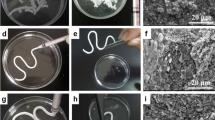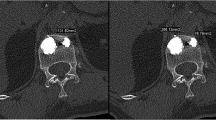Abstract
Vertebroplasty (VP) and balloon kyphoplasty (BKP) are now widely used for treating patients in whom the pain due to vertebral compression fractures is severe and has proved to be refractory to conservative treatment. These procedures involve percutaneous delivery of a bolus of an injectable bone cement either directly to the fractured vertebral body, VB (VP) or to a void created in it by an inflatable bone tamp (BKP). Thus, the cement is a vital component of both procedures. In the vast majority of VPs and BKPs, a poly(methyl methacrylate) (PMMA) bone cement is used. This material has many shortcomings, notably lack of bioactivity and very limited resorbability. Thus, there is room for alternative cements. We report here on two variants of a novel, bioactive, Al-free, Zn-based glass polyalkenoate cement (Zn-GPC), and how their properties compare to those of an injectable PMMA bone cement (SIMPL) that is widely used in VP and BKP. The properties determined were injectability, radiopacity, uniaxial compressive strength, and biaxial flexural modulus. In addition, we compared the compression fatigue lives of a validated synthetic osteoporotic VB model (a polyurethane foam cube with an 8 mm-diameter through-thickness cylindrical hole), at 0–2300 N and 3 Hz, when the hole was filled with each of the three cements. A critical review of the results suggests that the performance of each of the Zn-GPCs is comparable to that of SIMPL; thus, the former cements merit further study with a view to being alternatives to an injectable PMMA cement for use in VP and BKP.



Similar content being viewed by others
References
Watts NB, Harris ST, Genant HK. Treatment of painful osteoporotic vertebral fractures with percutaneous vertebroplasty kyphoplasty. Osteop Int. 2001;12:429–37.
Strom O, Borgstrom F, Zethraeus N, Johnell O, Lidgren L, Ponzer S, et al. Long-term cost and effect on quality of life of osteoporosis-related fractures in Sweden. Acta Orthop. 2008;79:269–80.
Johnell O. Economic implication of osteoporotic spine disease: cost to society. Eur Spine J. 2003;12 Suppl 2:S168–9.
Lin JT, Lane JM. Nonmedical management of osteoporosis. Curr Opin Rheumatol. 2002;14:441–6.
Pateder DB, Khanna AJ, Lieberman IH. Vertebroplasty and kyphoplasty for the management of osteoporotic vertebral compression fractures. Orthop Clin North Am. 2007;38:409–18.
Peh WCG, Munk PL, Gilula LA. Percutaneous vertebral augmentation: vertebroplasty, kyphoplasty and skyphoplasty. Radiol Clin North Am. 2008;46:611–35.
Lewis G. Injectable bone cements for use in vertebroplasty and kyphoplasty: state-of-the-art review. J Biomed Mater Res Part B: Appl Biomater. 2006;76B:456–68.
Lewis G. Properties of acrylic bone cement: state-of-the-art review. J Biomed Mater Res Part B: Appl Biomater. 1997;38:155–82.
Becker S, Franz K, Wilke I, Ogon M. Injectable bone cements in the treatment of spinal fractures, osteopromotive capacity and surgical considerations. Eur Cells Mater. 2006;11 Suppl 1:1.
Boger A, Bohner M, Heini P, Verrier S, Schneider E. Properties of an injectable low modulus PMMA bone cement for osteoporotic bone. J Biomed Mater Res Part B: Appl Biomater. 2008;86B:474–82.
Hernández L, Parra J, Vázquez B, López Bravo A, Collía F, Goñi I, et al. Injectable acrylic bone cements for vertebroplasty based on radiopaque hydroxyapatite. Bioactivity and biocompatibility. J Biomed Mater Res Part B: Appl Biomater. 2009;88B:103–14.
Wang X, Ye J, Wang Y. Influence of a novel radiopacifier on the properties of an injectable calcium phosphate cement. Acta Biomater. 2007;3:757–63.
Vlad MD, del Valle LJ, Poeata I, Barraco M, Lopez J, Torres R, et al. Injectable iron-modified apatitic bone cement intended for kyphoplasty: cytocompatibility study. J Mater Sci: Mater Med. 2008;19:3575–83.
Hernandez L, Munoz ME, Goni I, Gurruchaga M. New injectable and radiopaque antibiotic loaded acrylic bone cement. J Biomed Mater Res Part B: Appl Biomater. 2008;87B:312–20.
Lewis G, Schwardt J, Slater T, Janna S. Evaluation of a synthetic vertebral body augmentation model for rapid and reliable cyclic compression testing of materials for balloon kyphoplasty. J Biomed Mater Res Part B: Appl Biomater. 2008;87B:179–88.
Boyd D, Towler MR, Wren A, Clarkin OM. Comparison of an experimental bone cement with Surgical Simplex®P, Spineplex® and Cortoss®. J Mater Sci: Mater Med. 2008;19:1745–52.
Boyd D, Clarkin OM, Wren A, Towler MR. Zn-based glass polyalkenoate cements with improved setting times and mechanical properties. Acta Biomater. 2008;4:425–31.
Khairoun I, Boltong MG, Driessens FCM, Planell JA. Some factors controlling the injectability of calcium phosphate bone cements. J Mater Sci: Mater Med. 1998;9:425–8.
Gbureck U, Spatz K, Thull R, Barralet JE. Rheological enhancement of mechanically activated α−tricalcium phosphate cements. J Biomed Mater Res Part B: Appl Biomater. 2005;73B:1–6.
ISO 4049:2000. Dentistry—polymer-based filling, restorative and luting materials. Geneva, Switzerland: International Organization for Standardization (ISO); 2000.
ISO 9917-1:2003. Dental water based cements. Geneva, Switzerland: International Organization for Standardization; 2003.
Williams JA, Billington RW, Pearson GJ. The effect of the disc support system on biaxial tensile strength of a glass ionomer cement. Dent Mater. 2002;18:376–9.
Higgs WAJ, Lucksanasombool P, Higgs RJED, Swain MV. A simple method of determining the modulus of orthopaedic bone cement. J Biomed Mater Res Appl Biomater. 2001;58:188–95.
Akinmade AO, Nicholson JW. Poisson’s ratio of glass polyalkenoate (“glass-ionomer”) cements determined by an ultrasonic pulse method. J Mater Sci: Mater Med. 1995;6:483–5.
Diamond TH, Champion B, Clark WA. Management of acute osteoporotic vertebral fractures: a nonrandomized trial comparing percutaneous vertebroplasty with conservative therapy. Am J Med. 2003;114:257–65.
Gaitanis IN, Hadjipavlou AG, Katonis PG, Tzermiadianos MN, Pasku DS, Patwardhan AG. Balloon kyphoplasty for the treatment of pathological vertebral compressive fractures. Eur Spine J. 2005;14:250–60.
Molloy S, Mathis JM, Belkoff SM. The effect of vertebral body percentage fill on mechanical behavior during percutaneous vertebroplasty. Spine. 2003;28:1549–54.
Coumans J-VCE, Reinhardt M-K, Lieberman IH. Kyphoplasty for vertebral compression fractures: 1-year clinical outcomes from a prospective study. J Neurosurg: Spine. 2003;99:44–50.
Kasperk C, Hillmeier J, Noldge G, Grafe IA, Da Fonseca K, Raupp D, et al. Treatment of painful vertebral fractures by kyphoplasty in patients with primary osteoporosis; a prospective nonrandomized controlled study. J Bone Miner Res. 2005;20:604–12.
Li B, Aspden RM. Composition and mechanical properties of cancellous bone from the femoral head of patients with osteoporosis or osteoarthritis. J Bone Miner Res. 1997;12:641–51.
Banse X, Sims TJ, Bailey AJ. Mechanical properties of adult vertebral cancellous bone: correlation with collagen intermolecular cross-links. J Bone Miner Res. 2002;17:1621–8.
Baroud G, Bohner M. Biomechanical impact of vertebroplasty. Joint Bone Spine. 2006;73:144–50.
Schwardt J, Slater T, Lee S, Meyer J, Wenz R. KyphOs FSTM calcium phosphate for balloon kyphoplasty: verification of compressive strength and instructions for use. Eur Cells Mater. 2006;11 Suppl 1:28.
Boyd D, Towler MR. The processing, mechanical properties and bioactivity of zinc based glass ionomer cements. J Mater Sci: Mater Med. 2005;16:843–50.
Lewis G. Alternative acrylic bone cement formulations for cemented arthroplasties: present status, key issues, and future prospects. J Biomed Mater Res Part B: App Biomater. 2008;84B:301–9.
Arlot ME, Roux JP, Boivin G, Perrat B, Tsouderos Y, Delofire P. Effects of a strontium salt (S12911) on both tibial metaphysis and epiphysis in normal growing rats. J Bone Mineral Res. 1995;10:S356.
Belkoff SM, Mathis JM, Erbe EM, Fenton DC. Biomechanical evaluation of a new bone cement for use in vertebroplasty. Spine. 2000;25:1061–4.
Tomita S, Molloy S, Jasper LE, Abe M, Belkoff SM. Biomechanical comparison of kyphoplasty with different bone cements. Spine. 2004;29:1203–7.
Alvarez L, Perez-Higueras A. Percutaneous vertebroplasty in the treatment of osteoporotic fractures. In: Lewandrowski K-U, Wise DL, Trantolo DJ, Yaszemski MJ, White III AA, editors. Advances in spinal fusion: molecular science, biomechanics, and clinical management. New York: Marcel Dekker Inc.; 2004. p. 13–21.
Lewis G. Putting insoles through the paces. Mech Eng. 1989;111(4):96–8.
Acknowledgements
The authors thank Mr. Yuan Li and Dr. Si Janna, for their contributions to the compression cyclic fatigue life testing and the financial assistance of Enterprise Ireland for facilitating this work.
Author information
Authors and Affiliations
Corresponding author
Rights and permissions
About this article
Cite this article
Lewis, G., Towler, M.R., Boyd, D. et al. Evaluation of two novel aluminum-free, zinc-based glass polyalkenoate cements as alternatives to PMMA bone cement for use in vertebroplasty and balloon kyphoplasty. J Mater Sci: Mater Med 21, 59–66 (2010). https://doi.org/10.1007/s10856-009-3845-7
Received:
Accepted:
Published:
Issue Date:
DOI: https://doi.org/10.1007/s10856-009-3845-7




